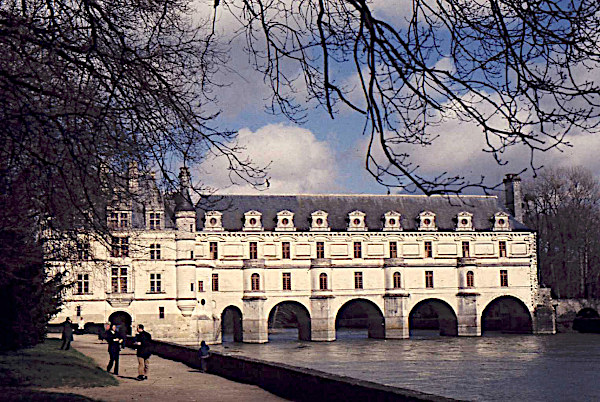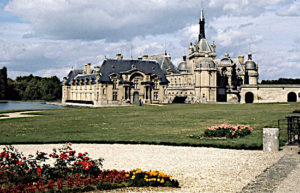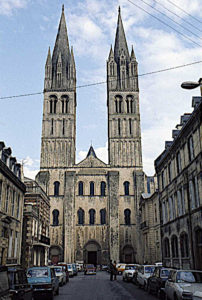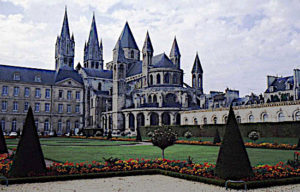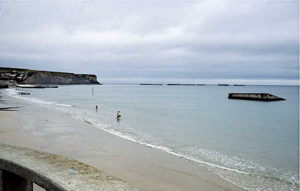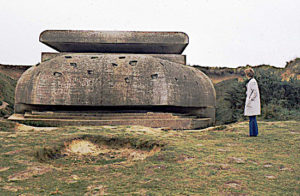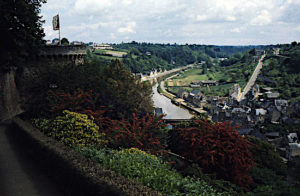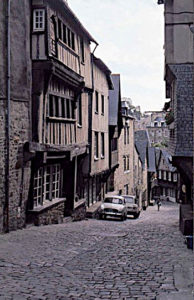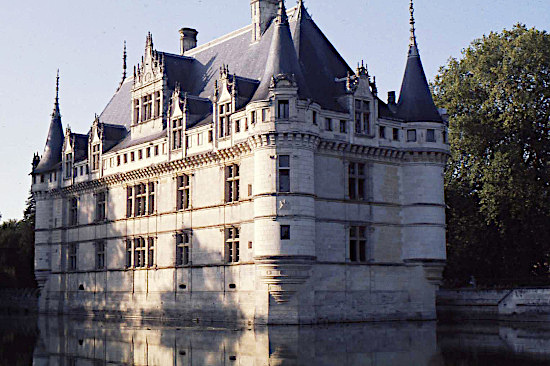When John’s parents came to visit with us in September 1974 we made a trip into World War II history, among other things, before ending up at La Fontaine. On our way to Normandy we first made a stop at le Château de Chantilly just north of Paris.
We made a tour of the interior of this château and I found an antique dresser, if it can actually be referred to by such a mundane name, that seemed to be identical to one that Tante Gerda had and that Arne inherited when she died in the late sixties while I was in the United States. This impressive black meuble had once belonged to a Portuguese ambassador in Stockholm before Tante Gerda’s parents bought it. It was amazing to see a replica of that dresser in a château in France. The style was French rococo and it seems obvious that they were both made in France. The two dressers can not have been absolutely alike, but definitely very much alike.
Our next stop was in Caen where John and I had never been. We were impressed by the very old Abbaye aux hommes, a mixture of romanesque and gothic architecture. The construction of this abbey began in 1066, the same year William the Conqueror conquered England by winning the Battle of Hastings. William is actually buried in the abbey. Seen from behind there is a more recent building that used to be a convent and has now become l’Hôtel de ville (City Hall).
There is also an Abbaye aux Dames in Caen, finished in 1120, but I liked it less. The extremely pure-looking facade of l’Abbaye aux Hommes fascinates me. It was a kind of architecture I had never seen before. I seem to have a predilection for Romanesque churches. It is true that Lund cathedral is probably the most beautiful church I have ever seen (See Chapter 9 – Lund – a Love story), but l’Abbaye aux Hommes is even simpler and also very different. So no competition is necessary.
Of course gothic churches can be magnificent and my favorite of that architectural style is no doubt Notre Dame de Paris, which is not as ornate as many others. And of course we must not forget to mention Westminster Abbey in this context. Construction of the present church began in 1245, and it is known to be the finest example of Anglo-French Gothic style in all of England. As early as the 11th century when l’Abbaye aux Dames was constructed, there were some Gothic frills that I think take away from the grandeur. In fact, it is a mixture of styles that I find a bit disturbing.
Our next goal was Bayeux, inland from the landing beaches, to see the very famous and fabulously alive ‘tapisseries de Bayeux‘. From Normandy we traveled west to St Malo, a historic town in Brittany (Bretagne) and then to Dinan, another very old and very picturesque town.
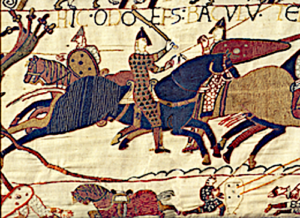
A scene from the Bayeux Tapestry depicting Odo, Bishop of Bayeux, rallying Duke William’s troops during the Battle of Hastings in 1066 — Wikipedia
We first wanted to see the famous ‘”tapisseries de Bayeux‘” from the 11th century, depicting the battle of Hastings in 1066 between the Norman-French army of William and the English army. It was the beginning of the Norman conquest of England by ‘William the Conqueror’ (Guillaume le Conquérant), duke of Normandy, who was to become king of England after the Battle of Hastings in 1066, one of those historic years that sits so firmly imprinted in our minds that it might well be the most remembered year in history ever for lots of Europeans.
It is quite certain that we were not allowed to take any photos inside where the tapisseries were displayed, so we don’t have a single picture of those quite amazing embroideries, but I still remember how very impressive they were. The movement in these broderies was striking, very different from the woven tapestries we had seen at the Musée de Cluny in Paris, for instance. These embroideries actually tell the story of the battle of Hastings. They date from the 11th century and are attributed by the French to la reine Mathilde, the wife of William the Conqueror, who would have been the artist behind this astounding masterpiece. Mathilde was duchess of Normandy, and later Queen of England. The tapestries were completed during the years between 1066 and 1082 – an amazing work of art.
_________________
Margaret and Bert wanted to see the beaches where the allied invasion of Normandy took place in June 1944, Arromanches-les-bains, Longues-sur-Mer – close by, with the biggest bunker I could ever have imagined.
From Bayeux, we went on to the coast of Normandy, the landing beaches during the allied invasion in June 1944. We first visited Arromanches-les-Bains, where you can still see some of the ‘mulberries’ that the Allies had sunk into the water by the beach, probably just before the boats with the soldiers arrived, in order to create a kind of harbor that would keep the men from drowning in rough water. There were also mine-sweepers that preceded the boats with the landing craft, since the Channel was studded with mines.
From there we went on to Longues-sur-Mer, where we visited the enormous military cemetery. We did not make it as far west as Omaha Beach. where the Allied soldiers had to climb up steep cliffs. and thousands were killed.
“The Normandy landings (code-named Operation Neptune) were the landing operations on Tuesday, 6 June 1944” 1 The invasion came as a bad surprise for the Germans. An allied attack somewhere was of course expected, but not at that time since the weather during the first half of June was forecast to be execrable with severe storms – and nor were the Allies expected quite at that place. The Germans were not aware of the one lull on June 6, since their weather forecast services were less sophisticated than one allied weather station.2
Wild confusion reigned on that day and it is still not established with certainty how many allied soldiers lost their lives during this gruesome and final counterattack on the German occupiers of France. The battles continued of course for quite some time and became extremely cruel farther inland, once the Germans belatedly found out what was going on and met the allied invaders with infantry troops. Only one German air-force strike occurred, as most of the German Luftwaffe had been called back to Germany, since no allied invasion was expected just then. There were also some belated Panzer attacks.
HistoryNet declares “D-Day: The Beginning of the End for Nazi Germany” but this is very clearly a biased US-UK headline. The beginning of the end took place with the crucial and seemingly never-ending battle of Stalingrad July 1942 – February 1943. “It is often regarded as the single largest and bloodiest battle in the history of warfare.”3 Both sides lost monstrous numbers of soldiers, but Germany was essentially beaten after that. They had also lost the war in Africa after the second battle of El Alamein, and the Japanese were decisively beaten at Guadalcanal in the Pacific.4 The Nazi generals wanted to end the war, but Hitler refused. He survived a coup attempt against him by his top generals and the war went on until May ’45 when Hitler committed suicide in his bunker in Berlin after making sure his wife Eva Braun had committed suicide just before he did.5
__________________
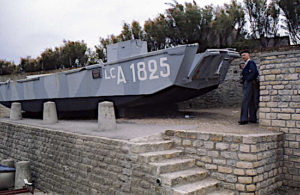
Margaret and Bert standing next to a landing craft, a museum piece from the Allied landing in June 1944 .
It is difficult to realize the hardship the soldiers went through in this final battle to beat the German occupiers of western Europe. It began with the landing in water that was often too deep for easy approach to the shoreline, and from the beginning a barrage of enemy fire made for many thousands of casualties on both sides. After that followed the move inland where they were again exposed to the German Luftwaffe and infantry. Heavy fighting took place for weeks, and even months further inland, before the Germans were beaten back.
The crucial role of the French resistance must also be stressed. Coded messages went out from the UK via the BBC that were picked up by the Resistance networks so that they would know what was going on and when the invasion was going to take place. The rest was up to the resistance leaders. They blew up bridges and railroads to inhibit German progress and so played a big part in helping the advancement of the allied soldiers. The messages consisted of lines from a poem by Verlaine, “Chant d’automne”.6 The final retreat of the Germans took place in August. About 20,000 men from both sides lost their lives just in these final battles, all due to the insanity of a callous madman who once had dreams about conquering the world. At this point though, his own officers knew that he had gone insane and that he was incapable of strategic planning and also of human feelings.
The Germans were largely caught unawares since for one thing the weather was so dreadful during the first half of June that they considered an allied amphibious invasion realistically impossible. Furthermore, they had expected an allied invasion to take place at Pas de Calais where the Channel was the narrowest. Field Marshal Erwin Rommel was in Germany celebrating his wife’s birthday, which seemed like a reliable sign that the invasion was not expected during the three days the allied command had considered a landing possible.

Mausoleum and cemetery at Longues-sur-Mer commemorating the thousands of dead, mostly American soldiers during the Allied invasion in Normandy.
The Germans were not aware of the lull in the heavy storm that was forecast for Tuesday June 6. The Germans had also withdrawn most of their aircraft in France to strengthen their home defenses.
Nevertheless the German defense was forceful and the allied losses were monumental. Omaha Beach was the site of the worst allied disaster. The two American landing beaches were Omaha and Utah and Utah was as successful as Omaha was disastrous. The British sustained less heavy casualties on their landing beaches, but the Canadians were less fortunate at Juno Beach where they met heavy German resistance. However, by and large, the British invaders met less fierce enemy fire than the Americans. The same morning the allied air force had bombarded inland sites of German encampments to clear the way for their own infantry and artillery that would come behind. They also dropped great numbers of parachuters inland, but those, tragically, were often gunned down as too easy targets for the German occupation forces. The entire scene was one of sheer horror from Utah beach to Canadian Juno and British Sword beaches farther east, but the American forces did in the end suffer the heaviest losses.
“The commander of the 352nd German Infantry Division believed that the situation at Omaha was completely under control and that the Americans would soon be defeated. He decided then to commit his reserves to other areas.
From HISTORYNET:
“On Omaha Beach, soldiers who had previously been paralyzed with fear came out of their shock and began to move inland. Instrumental in shaking the paralysis were a few brave soldiers who defied enemy fire and inspired the others to advance.”
“The U.S. Navy supplied critical fire support for the soldiers attempting to move off the beaches and take the commanding positions along the bluffs from their German defenders. Some destroyers came in so close to shore with their supporting fire that they risked running aground. Slowly, painfully, the men at Omaha began to overcome the German strongpoints that had previously pinned them down.”..
“Hitler’s Atlantic Wall 7 had failed to hold back the Allied invasion. The invaders were not destroyed on the beaches as Rommel had hoped, nor were they thrown back into the sea as Rundstedt had planned. The Germans kept the Allied army contained for two months. When the breakout occurred in August, there was no holding the Allies back. From that point, Nazi Germany had only nine months more to live.”
_______________
John and I once, in Inverness Scotland in 2005, the evening before taking the plane back home, were having dinner in a nice quiet restaurant, when I noticed that a gentleman, sitting alone not far from us on my left side, was discretely paying attention to what we were talking about. As he got up to leave and as we were also about ready to leave he approached our table. Introducing himself and chatting for a while, he then invited us to come over to his home for a talk and a little glass of what turned out to be an excellent liqueur.
Once in his home he told us that he had been a pilot during D-Day and that he, who must now have been well past 80, was in a week or so going to Arnhem 8 in Holland to attend a memorial reunion of veterans from D-Day. He seemed old, but I of course invited him to come and see us here in Genas, close to Lyon, as well. Frankly I did not expect him to pick up on my invitation.
We spent a couple of hours with this very nice and interesting man looking at his albums from the war and tasting his excellent liqueur. A very pleasant evening, but of course, in spite of exchange of cards, we never heard from him again. It felt as if we had met a ghost from the allied invasion of Normandy.
________________
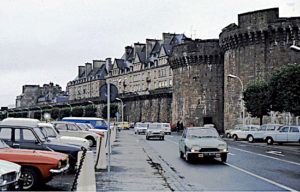
Saint Malo and a piece of the beautiful fortresses that surround the old city and that protected the harbor from “seaborne raiders”, but not airborne ones.
Meanwhile, back to the year 1974 and our travels with John’s parents. From Normandy we continued our trip to Saint-Malo, a walled port city in Brittany (Bretagne) that we had heard much about but never been to. It was founded by Gauls in the 1st century B.C. The old town is fascinating and it has a long history. “Saint-Malo became notorious as the home of the corsairs, French privateers and sometimes pirates.” (Wikipedia)
After visiting Saint–Malo, we continued to Dinan. We, John and I, had been to Dinan in the spring of 1971 during our many travels that year.
John is the best guide I have ever known, and we made quite a thorough visit of the beautiful historic town of Dinan. And so much the better that we had already been there in 1971. We love this beautiful medieval town, the very old houses and the cobblestone streets, some of them leading downhill to the beautiful river and valley. Dinan is a very special town, and I am sure Bert and Margaret also appreciated its hilly old streets and historic houses. Dinan is situated on the river Rance, mostly on the hills above the river, which gives it an exceptional beauty.
From Bretagne we went south to visit some of the famous Renaissance châteaux in le Val de Loire. We stopped to admire three of them, Villandry and its fabulous French gardens, gorgeous Chenonceaux, its gallery spanning the river Cher. During World War I the new owner of the château who was also the owner of the Menier chocolate factories turned the long gallery into a military hospital.9
After also admiring its gardens, we went on to Azay-le-Rideau, the fairy-tale château if there ever was one. John and I had been to Villandry before, in 1971, and we had been to both Chenonceau and to Azay-le-Rideau at least once before, but these châteaux are so gorgeous they are always nice to revisit.
After the tours of these châteaux, La Fontaine was a natural end point of a historic round-trip through the north of France, even though it was definitely not up to the standards of American parents.
We were going to get back to Chenonceau later on the same year with sister Marjie on her visit to Paris and our niece Kajsa, who was a student at la Sorbonne. We traveled around Paris quite a bit with Marjie during this visiy and often Kajsa was with us too. We went to Versailles of course, including “le petit hameau” of queen Marie Antoinette, among other places – and we visited several châteaux in le Val de Loire once again, with La Fontaine as the point of departure.
After this long and eventful tour of northern France we ended up at La Fontaine where construction work had been going on for the entire summer and we had finally made pretty much finished the assainissement. The base of the house was duly filled in with smooth-looking cement and it was just the spreading of stones next to the cement that needed to be finished. Bert was very happy to help John with that job. Or maybe vice versa actually. I already talked about that in the last chapter.
John would do the painting in nice brown of the newly installed gutters and drainpipes. He did that in the spring of 1975 and we also painted the living room at that time, walls and ceiling.
Extensive upgrading of the surrounding terrain, both the courtyard and the large area in the back of the house was going to continue through 1977, made possible because of a drought and a flood beginning in 1976. Quite dramatic.
Continued; Chapter 28 (Part 1) Thirteen years in Paris
- D-Day of the Allied invasion of Normandy in Operation Overlord during World War II” ↩
- For those who are interested in WWII history, there is interesting reading at: The Weather Forecast That Saved D-Day ↩
- Battle of Stalingrad 1942/1943 – Nazi Germany vs Soviet Union (video) ↩
- Guadalcanal Campaign, 7 August 1942 – 9 February 1943 ↩
- “As Nazi Germany was collapsing towards the end of the war, Braun swore loyalty to Hitler and went to Berlin to be by his side in the heavily reinforced Führerbunker beneath the Reich Chancellery. As Red Army troops fought their way into the neighborhood on 29 April 1945, she married Hitler during a brief civil ceremony; she was 33 and he was 56. Less than 40 hours later, they committed suicide together in a sitting room of the bunker, she by biting into a capsule of cyanide, and he by a gunshot to the head. The German public was unaware of Braun’s relationship with Hitler until after their deaths.” (Wikipedia) The German High Command surrendered unconditionally on May 7, 1945 in Reims. General Jodl signed the papers on General Eisenhower’s explicit insistence that it be a complete capitulation. The total surrender was announced on May 8, which became a national holiday in France, and still is. ↩
- These numerous messages announce the beginning of the sabotage operations: the local resistants destroy railroads, telephone lines and install anti-tank mines on the roads. The night between June 5 and June 6, 1944, nearly 1,000 sabotage actions are carried out by the French resistance. French Resistance ↩
- The Atlantic Wall (German: Atlantikwall) was an extensive system of coastal defence and fortifications built by Nazi Germany between 1942 and 1944 along the coast of continental Europe and Scandinavia as a defence against an anticipated Allied invasion of Nazi-occupied Europe from the United Kingdom during World War II ↩
- Battle of Arnhem – Wikipedia ↩
- History ↩


